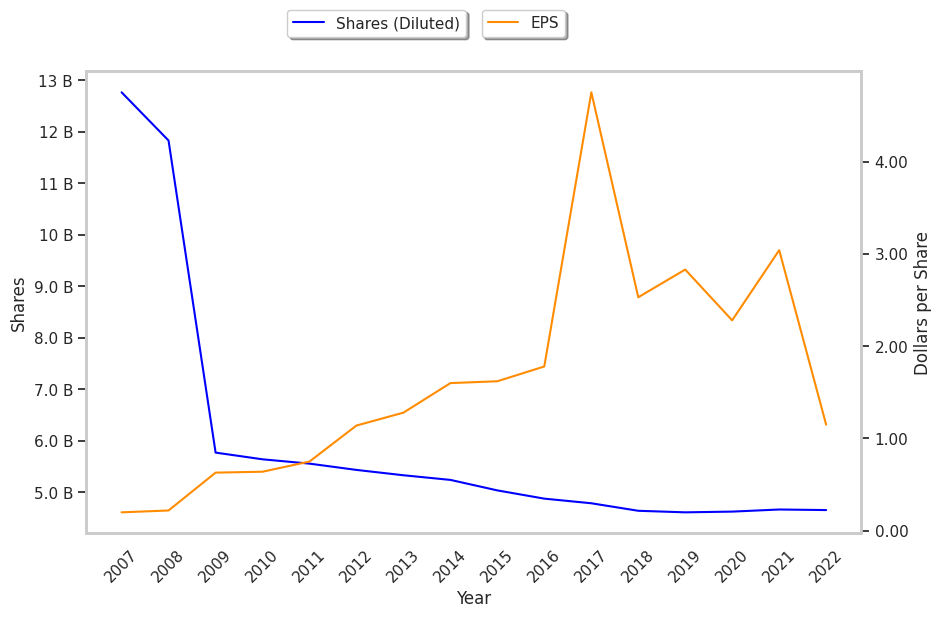Comcast (CMCSA) stock climbed 1.1 % this afternoon. According to our metrics, the company seems overvalued at today's prices. In the below analysis, we will put Comcast's valuation in the context of its mixed growth prospects and mixed market sentiment, which are also strong drivers for share price.
Comcast Corporation operates as a media and technology company worldwide. The large-cap Telecommunications company is based in Philadelphia, United States and has 186,000 full time employees.
CMCSA Has a Higher P/E Ratio Than the Sector Average
Compared to the Telecommunications sector's average of 18.85, Comcast has a trailing twelve month price to earnings (P/E) ratio of 28.4 and an expected P/E ratio of 10.7. The P/E ratios are calculated by dividing the company's share price by its trailing 12 month of $1.59 or forward earnings per share of $4.21.
Earnings represent the net profits left over after subtracting costs of goods sold, taxes, and operating costs from the company's recorded sales revenue. One way of looking at the P/E ratio is that it represents how much investors are willing to pay for every dollar's worth of the company's earnings. Since Comcast's P/E ratio is higher than its sector average of 18.85, we can deduce that the market is overvaluing the company's earnings.
Comcast Is Fairly Valued in Terms of Expected Growth
Another factor pointing to Comcast's value is its PEG ratio of 1.59. This is the stock's price to earnings ratio divided by its estimated earnings growth rate. If the resulting ratio is near or lower than 1 -- but higher than 0 -- its indicates that the company is faitly valued in terms of expected growth.
CMCSA Has an Average P/B Ratio
Traditionally, stock pickers used to focus primarily on finding issues that were trading significantly below their tangible asset value, to guarantee themselves a margin of safety. But such an approach would screen out many valuable securities because many profitable businesses -- especially those that heavily leverage information technology -- simply do not have many tangible assets compared to more capital intensive companies.
Therefore, modern value investors tend to focus less on absolute price to book value (P/B) ratios. Instead of singling out stocks with a P/B ratio of less than 1, they will compare the target company against its peer group. For Comcast, the P/B value is 2.22 while the average for the Telecommunications sector is 3.12.
CMCSA's Weak Cash Flow Generation Is Troubling
The table below shows that Comcast is not generating enough cash. A well run company will generally have cash flows that reflect the strength of its underlying business, and in Comcast's case, free cash flow is growing at an average rate of 0.0% with a coefficient of variability of 84178899993.5%. We can also see that cash flows from operations are evolving at a 0.0% rate, versus 0.0%:
| Date Reported | Cash Flow from Operations ($ k) | Capital expenditures ($ k) | Free Cash Flow ($ k) | YoY Growth (%) |
|---|---|---|---|---|
| 2023-02-03 | 26,413,000 | -13,767,000 | 40,180,000 | -2.49 |
| 2022-02-02 | 29,147,000 | -12,057,000 | 41,204,000 | 13.29 |
| 2021-02-04 | 24,737,000 | -11,634,000 | 36,371,000 | -4.6 |
| 2020-01-30 | 25,697,000 | -12,428,000 | 38,125,000 | 5.89 |
| 2019-01-31 | 24,297,000 | -11,709,000 | 36,006,000 | 9.66 |
| 2018-01-31 | 21,261,000 | -11,573,000 | 32,834,000 |
Comcast's Margins Are Strong
If you buy a stock for the long run, you want the underlying business model to be profitable. Gross margins tell you how much profit the company generates compared to the cost of revenue, which is the cost directly related to providing Comcast's goods and services. Operating margins, on the other hand, tell you how much of these profits the company keeps after you take overhead into account.
Comcast's Gross Margins
| Date Reported | Revenue ($ k) | Cost of Revenue ($ k) | Gross Margins (%) | YoY Growth (%) |
|---|---|---|---|---|
| 2023-02-03 | 121,427,000 | -38,213,000 | 69 | 2.99 |
| 2022-02-02 | 116,385,000 | -38,450,000 | 67 | -1.47 |
| 2021-02-04 | 103,564,000 | -33,121,000 | 68 | 0.0 |
| 2020-01-30 | 108,942,000 | -34,440,000 | 68 | -1.45 |
| 2019-01-31 | 94,507,000 | -29,692,000 | 69 | -1.43 |
| 2018-01-31 | 85,029,000 | -25,355,000 | 70 |
Comcast's Operating Margins
| Date Reported | Total Revenue ($ k) | Operating Expenses ($ k) | Operating Margins (%) | YoY Growth (%) |
|---|---|---|---|---|
| 2023-02-03 | 121,427,000 | -60,590,000 | 19 | 5.56 |
| 2022-02-02 | 116,385,000 | -57,118,000 | 18 | 5.88 |
| 2021-02-04 | 103,564,000 | -52,950,000 | 17 | -10.53 |
| 2020-01-30 | 108,942,000 | -53,377,000 | 19 | -5.0 |
| 2019-01-31 | 94,507,000 | -45,806,000 | 20 | -4.76 |
| 2018-01-31 | 85,029,000 | -41,656,000 | 21 |
Comcast's cost of revenue is growing at a rate of -0.0% in contrast to -11.6% for operating expenses. Sales revenues, on the other hand, have experienced a 0.0% growth rate. As a result, the average gross margins growth is -0.1 and the average operating margins growth rate is -2.0, with coefficients of variability of 1.5% and 7.4% respectively.
Comcast Benefits From Positive Market Signals
The market sentiment regarding Comcast is overwhelmingly positive. The stock has an average rating of buy and target prices ranging from $55.0 to $39.0. CMCSA is trading -7.82% away from its target price of $48.92. 1.1% of the company's shares are tied to short positions, and 87.9% of the shares are held by institutional investors.
| Date Reported | Holder | Percentage | Shares | Value |
|---|---|---|---|---|
| 2023-06-30 | Vanguard Group Inc | 9% | 390,360,150 | $17,602,627,299 |
| 2023-06-30 | Blackrock Inc. | 8% | 314,159,824 | $14,166,503,149 |
| 2023-06-30 | Capital International Investors | 4% | 172,032,998 | $7,757,535,565 |
| 2023-06-30 | State Street Corporation | 4% | 160,119,465 | $7,220,315,049 |
| 2023-06-30 | FMR, LLC | 3% | 119,789,016 | $5,401,682,019 |
| 2023-06-30 | Massachusetts Financial Services Co. | 2% | 100,214,781 | $4,519,015,170 |
| 2023-06-30 | Capital Research Global Investors | 2% | 98,244,335 | $4,430,161,258 |
| 2023-06-30 | JP Morgan Chase & Company | 2% | 91,465,024 | $4,124,459,754 |
| 2023-06-30 | Capital World Investors | 2% | 88,869,896 | $4,007,436,869 |
| 2023-06-30 | Geode Capital Management, LLC | 2% | 80,409,013 | $3,625,907,735 |



